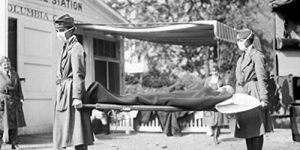
Not Much Change? 1918 Pandemic vs 2020 Pandemic
Part 2 of 2
To put things in perspective, here are some facts about the 1918 Spanish flu and other modern day pandemics from the Center for Disease Control’s website:
It was caused by an H1N1 virus with genes of possible avian origin. It is estimated that about 500 million people, or one-third of the world’s population, became infected (the world population was 1.8 billion at that time; in 2019 it was almost 7.6 billion people). The number of deaths was estimated to be at least 50 million worldwide, with about 675,000 occurring in the U.S. The number of healthy 20-40 year olds who succumbed to this disease was a unique feature. More U.S. soldiers died from this flu pandemic than were killed in battle during World War I in 1918. In spite of its virulence, most patients experienced typical flu symptoms followed by complete recovery.
There were no flu vaccines, no antiviral drugs, no mechanical ventilators, and no antibiotics to treat secondary bacterial infections. Control efforts worldwide were limited to non-pharmaceutical interventions such as isolation, quarantine, good personal hygiene, use of disinfectants, and limitations of public gatherings, which were applied unevenly.
Three other pandemic (worldwide) outbreaks of influenza occurred before the current Covid-19 pandemic. The H2N2 (Asian) flu of 1957 and the H3N2 (Hong Kong) flu of 1968 each resulted in an estimated 1 million global deaths. The 2009 H1N1 pandemic resulted in less than 0.3 million deaths in its first year. There have also been three notable epidemics – a pseudopandemic in 1947 with low death rates, an epidemic in 1977 that was a pandemic in children, and an abortive epidemic of swine flu in 1976 that was feared to have pandemic potential. Major influenza epidemics show no predictable periodicity or pattern, and all differ from one another.
“Flu viruses continue to pose one of the world’s greatest public health challenges, and the risk of a flu pandemic is always there.”
While the world was much more prepared for the current novel (new strain) coronavirus, more work needs to be done, both here in the U.S. and internationally.
Terry Pfau DO, HMD
